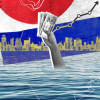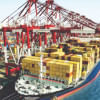Why Bangladesh needs a national maritime roadmap

There is something quietly dignified about the way a vessel enters port. Precision. Momentum. Timing. A ballet of steel and water.
It's an apt metaphor for where Bangladesh stands now—on the edge of something far greater than what our coastal skyline presently reveals.
For a country crisscrossed by rivers, bracketed by the Bay of Bengal, and reliant on maritime trade for over 90 percent of its economic throughput, Bangladesh remains paradoxically ill-prepared for the future of the ocean economy. Our ports are congested. Our vessels are outdated. Our policies are often detached from operational realities. And our systems, if they can be called that, function in fragmented silos, operating closer to analogue than digital. It is time for the story to change.
Bangladesh's coastline spans more than 700 kilometres. Our inland waterways stretch over 24,000 kilometres, forming one of the largest navigable river networks in the world. Chittagong Port, despite chronic backlogs, remains among the busiest in South Asia. Mongla and Payra sit strategically near regional trade corridors and domestic industrial zones. Matarbari, with deep-sea capacity, will soon be able to berth mother vessels.
But geography, while a gift, is not a guarantee.
Without institutional will, policy coordination, and technological foresight, strategic location alone will not deliver the maritime future Bangladesh is capable of building.
This is why I am advocating for Bangladesh's first National Maritime Roadmap—a data-driven, institutionally coordinated, multi-phase plan to transform the country from a passive trade corridor into a strategic maritime nation.
This roadmap is not a wishlist of terminals and tugs. It is a long-overdue blueprint to align the moving parts of our maritime economy, from ports and policy to people and platforms, under a single national vision.
It is built on eight strategic pillars, each informed by international benchmarks and real-world relevance.
A unified maritime authority
Fragmentation is our Achilles' heel. Core mandates such as port operations, shipbuilding policy, and maritime education remain scattered across disconnected authorities, while trade bodies, labour unions, and industry associations operate in silos, seldom aligned under a common strategy. To unlock the sector's full potential, we must consolidate these functions under a single, empowered entity that fosters coordination, transparency, and ease of doing maritime business. The establishment of the Bangladesh Maritime Commission—a one-stop authority for national nautical affairs, modelled after the Maritime and Port Authority of Singapore or the Norwegian Coastal Administration—would provide the institutional clarity and unified leadership needed to drive meaningful, long-term execution.
Infrastructure that speaks to the 21st century
We must move beyond viewing ports as isolated assets. The objective is not merely capacity expansion, but the development of a networked maritime ecosystem: one that integrates digitised ports, high-throughput shipyards, and inland terminals seamlessly connected to coastal feeder routes, all underpinned by enabling regulatory frameworks. Initiatives such as the proposed Laldia container terminal and Bay Terminal signal a positive step towards decentralising vessel berthing capacity. Yet, this ambition must extend further, encompassing smaller-scale and inland infrastructure projects within a unified national strategy. The Netherlands and the UAE have successfully built such integrated systems. Bangladesh must do the same with intention and urgency.
PPPs and maritime investment zones
Maritime growth is not the sole responsibility of the state. It is fundamentally a private-sector growth engine. To unlock its full potential, Bangladesh must attract and deploy international capital across shipyards, terminals, and logistics corridors through public-private partnerships, sovereign maritime bonds, and blended finance mechanisms. Global players such as Red Sea Gateway Terminal, Maersk, and DP World have committed and are in discussions to invest in Bangladesh's maritime infrastructure, offering optimistic signals of foreign direct investment appetite. While the long-term success of these models remains to be seen, the upside—capital infusion, technology transfer, and operational efficiency—is undeniable. India's Sagarmala programme stands as a compelling case study in maritime-led development.
Sovereign maritime capability through policy reform
Maritime sovereignty begins with ownership, and Bangladesh must take bold steps to increase its share of nationally owned vessels across cargo, offshore, and support segments. To achieve this, the government should implement a suite of targeted policies—including duty and VAT exemptions on vessel imports, access to low-interest financing, and guaranteed charter opportunities for domestically owned ships. Additionally, a Bangladesh Ship Finance Facility, capitalised through public-private partnerships, could provide long-term lending to emerging shipowners, enabling the growth of a truly diversified national fleet. Increasing the percentage of trade carried on Bangladeshi-flagged vessels not only enhances economic resilience but also keeps freight earnings and strategic control within our borders. As India and China have demonstrated, enabling domestic fleet expansion is both a commercial and geopolitical imperative.
Digitisation of the maritime chain
The global maritime economy no longer runs on paper and neither should ours. Bangladesh's ports must be fully integrated through a Port Community System (PCS)—a unified digital platform encompassing berth planning, customs clearance, crew management, vessel tracking, and intermodal coordination. The transformative impact of real-time data exchange between terminal operators, customs authorities, and inland transport networks on local commerce is undeniable. At the heart of this shift lies the digitisation of legacy systems, which forms the backbone of any serious modernisation effort. Asian countries such as Singapore and South Korea are already deploying advanced artificial intelligence to optimise port operations through predictive analytics, while terminals in China operate on fully paperless, automated infrastructures.
Green shipping and environmental compliance
Regulations such as IMO 2020 are not abstract ideals; they are non-tariff trade barriers in disguise. As an illustration, without scrubbers, ballast water treatment systems, and compliant waste management infrastructure, Bangladeshi vessels will increasingly be denied access to regulated ports and markets. The impact of environmental non-compliance is already visible: our $3 billion ship recycling industry, which underpins critical domestic supply chains such as steel re-rolling and engineering, is facing mounting pressure to modernise or be marginalised. Countries such as Norway and Japan have embraced green compliance not as a burden, but as a pillar of national industrial policy.
Emergency maritime response and salvage
No country that moves the vast majority of its trade by water can afford to improvise disaster response. Bangladesh urgently needs a national maritime emergency response framework: anchored by strategically positioned depots, modern salvage equipment, and rapid-response teams based in Chittagong, Mongla, and Payra. The risks are not theoretical; we've seen the global consequences when a single vessel blocks a critical shipping lane. Our strategic posture must evolve from reactive to proactive. The US offers a compelling model through its National Response Framework, which coordinates oil spill containment, maritime firefighting, and search and rescue through structured inter-agency collaboration between public institutions such as the US Coast Guard and private responders such as Resolve Marine. Adapting this public-private model to Bangladesh's context could dramatically enhance our preparedness and resilience in the face of maritime emergencies.
Our ports are congested. Our vessels are outdated. Our policies are often detached from operational realities. And our systems, if they can be called that, function in fragmented silos, operating closer to analogue than digital. It is time for the story to change.
Maritime education as economic strategy
The average age of marine engineers in Western economies is steadily rising. Bangladesh, with its youthful population, holds a clear demographic advantage—but only if we make the necessary investments in training, simulation, and certification. With the right infrastructure in place, we have a realistic opportunity to build a globally competitive maritime workforce. This means establishing new maritime colleges not only in major urban centres but across key coastal and riverine regions. High-quality training delivers long-term dividends: both for the individuals it empowers and for the country as a whole. A skilled maritime workforce working abroad sends back remittances that strengthen our foreign reserves, stabilise the economy, and reinforce our position in global labour markets. The Philippines and Indonesia have shown what's possible. Bangladesh has every reason and every resource to go further.
This roadmap does not call for miracle budgets: it calls for institutional courage.
We have the rivers. The coastline. The people. The market access. What we lack is not capacity, but cohesion.
Bangladesh is not a landlocked country, yet without strategic vision, we risk operating like one. The moment is ripe for both local and foreign enterprises to rise, invest, and deliver the maritime capabilities this nation urgently needs. We stand on thousands of years of maritime legacy, shaped by trade, craftsmanship, and resilience. Now is the time to build upon it. Not in theory, but in action.
Mohammad Raad Sarwar is the director of Finance and Strategy at Prantik Group.
Views expressed in this article are the author's own.
Follow The Daily Star Opinion on Facebook for the latest opinions, commentaries and analyses by experts and professionals. To contribute your article or letter to The Daily Star Opinion, see our guidelines for submission.

 For all latest news, follow The Daily Star's Google News channel.
For all latest news, follow The Daily Star's Google News channel. 








Comments